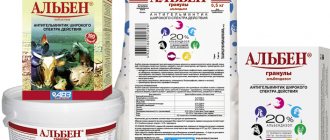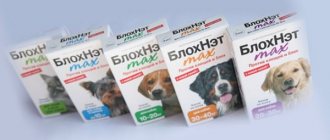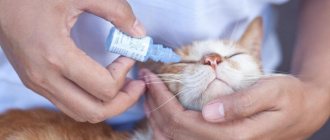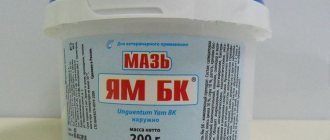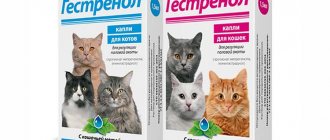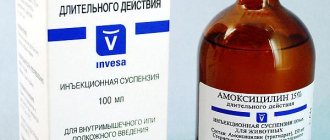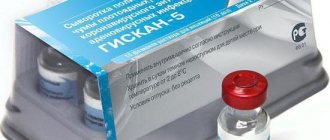Brief description of the properties of the active substance
Tetracycline ointment is a broad-spectrum medicine . This indicates that the drug can destroy any type of bacteria that causes the disease.
There is also evidence that tetracycline can rid the body of viruses and fungi.
Tetracycline can be used either intravenously, directly orally or topically . The most common form in the treatment of eye diseases is an ointment. It is very popular and quite widespread.
This is interesting: Is it possible to give Immunoglobulin to a cat?
Properties, pharmacodynamics
Tetracycline, which is part of the ointment, belongs to the group of complex universal antibiotics. It is highly effective against a large number of gram-positive and gram-negative pathogenic microorganisms, rickettsia, and fungi. Has a wide spectrum of action. Provides a prolonged effect.
Tetracycline ointment has a pronounced antiseptic, antibacterial, and anti-inflammatory effect. The mechanism of action of the active components is based on blocking protein synthesis by microbial cells.
Kittens' eyes fester and stick together: treatment with traditional methods
There are many ways to cure eye infection in a kitten. The treatment method depends on the original cause. When using the same medications for different ailments, treatment may be ineffective. The easiest way for such purposes is to use neutral agents that will help remove mucus, suppuration, and alleviate the kitten’s condition.
Kittens' eyes fester and stick together, treatment with traditional methods:
- Tea. It is necessary to brew strong tea, without adding fruit, moisten a gauze swab and apply it to the sore eye for a couple of minutes. Wait until the solids are completely dissolved in the tea.
- After this, you need to wipe with a swab from the outer corner of the eye to the inner. After this, you need to take new tampons. New swabs must be used for each eye.
- Chamomile tincture. For these purposes, you need to brew chamomile in the amount of 1 tablespoon of the herb per glass of boiling water. Keep it on low heat for 2 minutes. After this, you need to cool the mixture to a temperature of 20 degrees, moisten a gauze swab or cotton pad in the solution. In the same way, you need to hold it on the kitten’s eyelid for 2 minutes and rub from the outer corner of the eye to the inner one.
Is it possible to smear the eyes of cats?
After visiting a veterinary clinic and consulting with a veterinarian, a cat will be prescribed the use of ointment if a pathological eye disease is diagnosed by a doctor.
Tetracycline ointment is the most effective and common treatment. The only important point is the dosage of the drug and the duration of treatment. If the dosage is incorrect, irritation of the mucous membrane or skin may occur.
It is not recommended to use the drug if the animal is intolerant to this drug.
Other antibiotics should not be used when using tetracycline.
There are no antibiotics that would rid the body of the infectious agent once and for all; some can, on the contrary, provoke the growth and development of bacteria.
Tetracycline ointment is no exception in this case. Since the disease can be caused by a bacterium that cannot be destroyed by tetracycline.
After using the drug, you need to carefully monitor your pet’s well-being. If it worsens, stop using the ointment and consult a veterinarian.
Reviews from veterinarians
Oleg Eduardovich, veterinarian
1% antibacterial agent is a proven drug for treating eyes in pets. I use 3% tetracycline ointment to treat burns and skin infections. The drug is effective and cheap. I recommend it to patients.
Savelyev D. D., veterinarian
Antibacterial ointment is an outdated drug, since many microorganisms are resistant to the action of tetracyclines. The consistency of the medicine is not entirely successful; the animal licks it off, causing damage to health. I recommend using modern tools.
Mikheev O.V., veterinarian
I use eye ointment for cats to treat viral pathology. It is necessary to prescribe the medicine after establishing the sensitivity of the pathogen to AB. The drug does not help with chlamydia. I do not prescribe ointment to cats with a history of allergies to eliminate the risk of anaphylaxis.
All information posted on the site is provided in accordance with the User Agreement and is not a direct instruction to action. We strongly recommend that before using any product, you must obtain a face-to-face consultation at an accredited veterinary clinic.
Rules for using tetracycline ointment
If your pet is diagnosed with an eye disease caused by pathogenic microflora, you will have to smear the animal’s eyes.
But the use of the medicine is only after it has been prescribed by a veterinarian, who will need to be visited without fail.
Perhaps the doctor will prescribe additional specific treatments, but tetracycline ointment is not excluded, as it is prescribed for any ophthalmological disease .
The most important thing you need to know about the ointment. So this is how it should be applied correctly. Under no circumstances should you disregard your veterinarian's recommendations.
IMPORTANT! Don't go overboard with the quantity. After all, the dosage for kittens and puppies will be less than for adult animals.
The medicine is applied in an even thin layer, no more than a pinhead is consumed at one time. You can stop using the ointment only after your doctor’s permission , since infections are very dangerous.
Symptoms may disappear even after a short period of time, but the pathogen may linger on the affected area of the eye for a long time. If you stop treatment on your own and untimely, a relapse of the disease will occur.
The ointment should be applied specifically to the affected area; you should not smear it over the entire eyelid. To make it easier for the animal to apply the ointment, it is better to seek the help of a second person. One will hold the animal, and the second will open the animal's eyelids and carefully apply and distribute the ointment.
This entire procedure is carried out only with clean hands. During the process, it is advisable to try to put less pressure on the eyeball. It is usually recommended to apply the ointment approximately 2-6 times during the day . After applying the ointment, you need to massage the animal's eye with a sterile cotton swab.
In any case, the treatment will be prescribed by a doctor, and the duration of treatment depends only on him.
Watch the video in which you will learn how to properly apply tetracycline ointment for eye disease in animals:
Precautions and contraindications
When using the ointment in animals, an allergic reaction may occur, which manifests itself in the form of skin rashes, itching, swelling, and redness of the skin . If such symptoms appear, you should immediately stop using the ointment and consult a veterinarian to change the medication.
If the animal has already had a similar reaction to the cyclin group of drugs, you need to inform the specialist. It should also be remembered that tetracycline does not treat eye diseases caused by a cold.
In general, tetracycline does not cause side effects if the recommendations are followed.
There are some contraindications to the use of ointment:
- individual intolerance to the drug;
- simultaneous local use of other drugs;
- hypersensitivity to antibiotics of the cyclin group.
If a person gets a pet, then his health should be treated as carefully as his own.
At the first symptoms of the disease, you should immediately take the animal to a veterinary clinic for an appointment with a specialist.
He will examine the animal and determine whether there is a disease or not. In case of illness, he will prescribe the correct treatment.
This is interesting: How to give Ketofen to a cat?
Contraindications, side symptoms
Tetracycline ointment is well tolerated by animals. Side effects and complications are extremely rare if you adhere to the rules specified in the instructions for the medication.
Allergic reactions, drowsiness, depression, decreased activity, itching in cats are noted only in the case of individual intolerance to the active components of the drug by the cat’s body.
The pharmacological agent is contraindicated for the treatment of animals that have hypersensitivity to tetracycline or its analogues (oxytetracycline, chloretracycline). It is not recommended to use other antibiotics simultaneously with tetracycline ointment.
It is strictly unacceptable to let your cat lick the ointment. Remove excess drug with a sterile cotton pad. Carefully monitor the dynamics of the disease and the condition of your pet. If obvious side symptoms occur, contact your veterinarian.
Purpose and restrictions for use
Candidate of Veterinary Sciences Bolyakhina Svetlana Aleksandrovna has proven the effectiveness of “Tetracycline” for cats, cats and kittens in the treatment of all kinds of pustular diseases of the dermis and as a preventive measure for suppuration of wounds and bacterial lesions. In addition, the antibacterial effect of the medication also extends to other pathological conditions of the skin:
The drug can be prescribed to an animal with manifestations of allergic dermatitis.
- allergic dermatitis;
- acute purulent-necrotic, staphylococcal disease, accompanied by inflammation of the hair root;
- infectious lesion of the middle and deep parts of the hair follicle, provoking its purulent inflammation.
Tetracycline also treats bacterial eye infections, but in this case it is advisable to use an ointment with a 1% concentration. A cat can take tablets based on tetracycline hydrochloride if he has been diagnosed with salmonellosis, gastroenterocolitis, pasteurellosis and other ailments that are sensitive to this antibiotic. It is worth noting that the medicine in tablet form affects the cat’s intestinal microflora, killing not only pathogenic but also beneficial microorganisms, therefore, along with antibacterial therapy, medications that restore the pet’s intestinal flora are usually prescribed.
You cannot resort to antibiotic treatment if the cat has been identified as individual intolerant to the components of the drug, as well as to all tetracycline antibiotics. It is not recommended to apply tetracycline ointment to pets when using other antiseptic medications for external use together.
It is strictly contraindicated to let your cat lick the ointment, so excess must be removed with a sterile cotton pad.
Instructions for use
Tetracycline 1% ointment is prescribed to cats by veterinarians for the treatment of ophthalmological (eye) diseases of various origins, usually of viral or infectious etiology. Intended for external use only.
Tetracycline eye ointment is prescribed to animals for the treatment of:
- keratitis;
- uveitis;
- blepharitis;
- trachoma;
- serous, purulent, catarrhal conjunctivitis;
- other eye diseases, pathologies provoked by pathogenic flora.
It is possible that cats diagnosed with ophthalmological pathologies will be prescribed other medications, but tetracycline ointment forms the basis of complex therapy.
Important! Before use, be sure to consult a veterinarian and carefully read the instructions for the pharmacological drug.
Tetracycline ointment 3% is used to treat purulent, allergic dermatitis, furunculosis, folliculitis, burns, viral eczema, streptostaphyloderma. Helps well with trophic ulcers. Accelerates the healing of damaged dermis, stimulates regenerative processes in tissues.
Why and how is it used?
If your pet has uveitis, conjunctivitis or another eye pathology that is caused by pathogenic microflora, you will probably have to smear the cat's eyes with tetracycline ointment. Of course, your veterinarian (and you can’t do without a visit to him) will probably prescribe more specific medications, but this particular medicine is used for almost any ophthalmological disease.
It is important to use the ointment correctly! First, remember all your veterinarian's recommendations. It is very important not to overdo it with the quantity. For example, what is the dosage for kittens? The drug is applied in a thin layer, no more than a pinhead is needed per application.
Secondly, never stop using the ointment until your doctor tells you to do so. The fact is that infections are insidious. Their symptoms may already disappear, but the pathogen will still remain in the affected organ. If you stop using the ointment, a relapse of the disease may occur. So how many days should you give (that is, spread) this remedy? Once again, this should be decided by a veterinarian. It is better not to prescribe on your own.
Try to apply the ointment directly into the conjunctival cavity, rather than smearing it over the cat’s eyelids. The easiest way is to do this together: someone physically strong holds the angry cat, and the second one carefully parts the eyelids and applies a small amount of ointment behind the eyelid. This should be done exclusively with clean hands, trying not to press your finger on the eyeball. As a rule, you need to apply ointment to your cat's eyes at least two to six times a day, but it all depends on the specific disease and the recommendations of your veterinarian. After placing the medicine, you need to gently massage the animal’s eyelids with a sterile gauze swab.
Customer Reviews
Valentina, 22 years old. “Tetracycline ointment was prescribed by a veterinarian to treat a festering wound on a cat. I had to seriously struggle with applying bandages, because... the cat constantly tried to lick it off. In general, the product is cheap and effective, but it has its own nuances.”
Maria, 34 years old. “We treated a cat’s conjunctivitis with tetracycline ointment. Putting the ointment behind the eyelid was practically beyond fantasy, and after a few minutes it was gone, because the cat was constantly rubbing his eye with his paw, which irritated him even more. We switched to antibiotic drops and cured the eye much faster and more conveniently.”
In the video, a veterinarian shows how to put ointment in a cat's eye:
Undesirable consequences
Occasionally, the drug can cause an effect such as dry skin in the animal.
There have been no cases of negative effects of Tetracycline on the body of cats. The antibacterial drug is well tolerated and, when used correctly, does not provoke a negative reaction. But if you abuse the medicine and use it for a long time, dryness of the dermis or a reaction of local irritation of the pet’s epidermis may occur.
What can Tetracycline ointment be used and applied for?
This product has a wide range of applications:
- Styes and other superficial eye infections caused by Staphylococcus aureus, Streptococcus, Pneumococcus, Escherichia coli (1% ointment).
- In the treatment of eczema, folliculitis and other infectious purulent skin pathologies.
- For pimples (acne).
- Preventing or treating infection after abrasions, minor cuts, wounds or burns.
- In the treatment of vulvitis and other inflammatory processes of the external genital organs in women and men.
- 3% ointment comes in a 15 gram tube with an applicator, which is convenient for applying the medication directly to the skin.
- Apply the product to the affected area until the skin feels damp, then use your fingertips to spread the product over the skin and rub in. A second coat may be necessary to completely cover the affected areas.
- Be sure to wash the medicine off your fingers.
- You should apply Tetracycline ointment to the entire area affected by acne, eczema and other skin conditions, not just to the pustules themselves. This will help prevent the appearance of new pustules.
- Ointment 3% may burn the skin, so it should not be applied to the eyes, nose, mouth, or other mucous membranes. If Tetracycline does get into your eyes, rinse them immediately but carefully with plenty of cold tap water; if the burning sensation in your eyes does not go away after rinsing, consult your doctor.
What is Tetracycline 1% ointment for? For those cases when contact with the mucous membrane of the eye is necessary. The use of 1% Tetracycline ointment is also quite simple: a small amount of the drug is carefully placed behind the lower eyelid.
Dosage for skin infections:
- Adults and children over 8 years of age apply the ointment to the affected area once or twice a day; an occlusive dressing may be applied. The duration of treatment depends on the decision of the attending physician.
Dosage for eye infections:
- Adults and children over 5 years old - 3 to 5 times a day. The duration of treatment depends on the decision of the attending physician.
The safety of topical tetracycline preparations (3%) in children under 8 years of age has not been established.
Pregnant women should not use tetracycline ointment regularly, even around the eyes. Otherwise, the color of the child’s teeth may change (yellow) and the growth of skeletal bones may deteriorate; a single application of 1% eye ointment does not pose any harm to either the mother or the fetus.
The price of 1% Tetracycline ointment in Russian pharmacies is from 41 rubles.
The cost of 3% Tetracycline ointment is 38 rubles.
Available analogues:
- Several Russian enterprises are engaged in the production of 3% ointment with Tetracycline, including Biosintez, Nizhpharm, Sintez and Akrikhin. All these drugs have the same active ingredient, so they are interchangeable.
- An analogue of 1% Tetracycline ointment is Floxal eye ointment.
The instructions for using tetracycline eye ointment say that the active substance is a bacteriostatic antibiotic, which is part of the tetracycline group, its action is due to:
- The ability to disrupt the formation of complexes that destroy protein metabolism.
- Activity against gram-positive (staphylococcal, streptococcal) and gram-negative pathogenic microorganisms
After application, the drug begins to act locally and practically does not penetrate into the general bloodstream, which indicates the high safety of the ointment. If the corneal epithelium is damaged, the achievement of an effective concentration of the active substance is observed after half an hour.
How to handle drops and ointments for cats
Among the various means of treating cats, products such as various ointments and drops are often used, which are usually used in the treatment of diseases of the eyes and ears. And in order to get the maximum benefit from these funds, you should know exactly how to use them.
Unfortunately, many cat owners think that all they have to do is take their cat and drop some drug into its eye and that will be enough to solve the problem. In this article we will look at some of the nuances of using drugs that are available in ointments and drops.
How to properly use drops and ointments for cats.
How to administer eye drops to a cat
First of all, you should pre-treat the animal's eye. To do this, you need to use careful movements to wipe away all the discharge that has accumulated around the cat’s eyes. A cotton swab, which should be soaked in boiled water or tea, is best suited for this purpose. It is worth noting that a swab moistened with tea is not suitable for those cats whose hair around the eyes is white.
This is because tea leaves will turn the animal's fur a dirty color. It is also worth saying that you should not use a dry cotton swab, since thin cotton hairs can stick to the eye secretions and then disturb the animal and even get under the eyelid and cause irritation of the mucous membrane of the eye.
In addition to a cotton swab, you can also use a special swab for the eyes.
First, remove any discharge from the eye.
Next, you should check the dosage of the drug and, if necessary, shake the bottle with the drug.
Then you should ask an assistant (if you have one) to hold the cat by the front paws and hold it firmly in place.
After this, taking the bottle in one hand (thumb and index finger), you should support the pet's head with the other hand.
If the cat has closed its eyes, you need to slightly move the hand that holds the cat’s chin and use your thumb to lift the skin above the eye upward. Then you need to drop the required number of drops into the cat's eye, after which you can release the head and let it blink several times. Such blinking helps the medicine to spread better over the surface of the eyeball.
How to put ointment in a cat's eye
First, again, you should wipe off any discharge that may accumulate around the eye or in its corner using a special eye swab or a cotton swab dipped in boiled water.
A mandatory step is to check the dosage of the drug.
Next, the helper should hold the cat in place while the owner should place one hand on the cat's head. Use your thumb or index finger to gently push the skin above the upper eyelid upward.
The tube of medicine should be held parallel to the eyelids. Next, you need to carefully squeeze out the required amount of ointment so that it reaches the edge of the lower eyelid. After this, you can release the cat's head and let it blink once or twice.
However, unlike putting drops into the eye, in the case of ointment, the procedure does not end there.
After the cat has “blinked”, she needs to gently massage her closed eyelids so that the ointment spreads over the entire surface of the eyeball.
How to use ear ointments and drops
Open the cat's eye wider so that the drops fall on the entire surface.
The beginning of the procedure is quite standard: first you should check the correctness of the intended dosage and, if necessary, shake the bottle with drops.
The second stage is the same as before - you need to wipe away any secretions that may have accumulated around the ear opening, as well as on the inside of the ear.
To do this, you need to use a cotton swab, which, as in the case of the eyes, must be moistened in boiled water, or in tea leaves, or in a special solution for washing the ears.
Such solutions can be recommended directly at the veterinary hospital. You should not choose them at your own discretion - it is better to consult a veterinarian.
It must be said that putting drops into the ear or putting ointment there is quite difficult, since the owner does not see exactly how much of the medicine has traveled through the ear canal. In view of this, it would be a good idea to practice first by instilling drops or ointment into the auricle.
This will allow you to find out how hard you should squeeze the tube or vial so that the required amount of medicine comes out. An approximate procedure would look like this:
Calm the cat down.
Between your thumb and forefinger you should pinch the cat's ear, bending it outward. Then you need to insert the tip of the tube or bottle directly into the ear canal and release the medicine there.
Since your cat may start shaking its head, you should prepare for this in advance to prevent her from shaking her ear and getting rid of the medication. The ear should be massaged near its base. Then the drops or ointment can be directed along the curved ear canal to the eardrum.
In conclusion, a little more should be said about taking medications:
While the cat is being treated, under no circumstances should it be allowed to go outside.
Even if the pet feels very well, this still should not be allowed until the medication is finished.
Thanks to this “isolation”, the owner will be able to monitor its standing and recovery, and in addition, will always know where to look for the cat when it’s time for the next meal or the next treatment procedure.
After the procedure, try to pet the animal to calm it down.
Second: the course of treatment must be completed. Only a veterinarian can make certain adjustments to its course.
Even if the symptoms of the disease have noticeably improved, you still should not stop treatment, since courses of taking a number of drugs are designed to be taken for several days after apparent recovery.
If treatment is interrupted too early, the likelihood of relapse is quite high.
And third: you should definitely contact a veterinary hospital. Whatever problems arise during treatment for your cat, you should immediately contact your veterinarian or hospital.
, please select a piece of text and press Ctrl+Enter.
Source: https://kotello.ru/kak-nuzhno-obrashhatsya-s-kaplyami-i-mazyami-dlya-koshek/
Why do my kitten's eyes fester?
Suppuration in the eye area in kittens under 3 months of age is a fairly common problem. Moreover, this is not always associated with the influence of the external environment; most often, kittens are born with a problem that gets worse as the animal grows.
Why do a kitten's eyes fester?
- Chlamydia . Oddly enough, not only people, but also cats suffer from this disease. The disease is usually transmitted to kittens when passing through the mother's birth canal. A cat gives birth to her babies with chlamydia, which is why they have infectious conjunctivitis.
- Follicular conjunctivitis . Occurs when inflammation of the lymph nodes occurs. Along with discharge from the eyes, photophobia and swelling in the eyelid area will be observed. Please note that with this disease, hair around the eyes very often falls out.
- Purulent conjunctivitis . Most often it manifests itself in both eyes; with this disease, the cat experiences not only purulent discharge, but also an elevated temperature. Initially, the discharge from the eye area is very thin, but gradually becomes thick, with a green or yellow tint.
( 1 rating, average 4 out of 5 )
Advice and recommendations from experts
Antibiotics are serious drugs that can either harm the body or be beneficial. They can cure dangerous bacterial infections that can harm the cow and cause mass destruction of the herd. At the same time, antibiotics, including tetracycline, can only be used as prescribed by a veterinarian and only if it is impossible to do without them.
It is risky and irresponsible to prescribe such complex medications randomly or without a reason.
Monitor the dynamics of the disease
Alas, today not a single antibiotic is a sufficiently reliable guarantee of recovery. If there is no improvement within three to five days, be sure to consult your veterinarian. It may be necessary to more accurately identify the specific cause of the disease. It happens that tetracycline ointment in the eyes of a cat is used to treat simple conjunctivitis, while the disease itself arose against the background of chlamydia. This drug will not defeat him.
Tetracycline is one of the broad-spectrum antibiotics. 1% Tetracycline ointment is used to treat the eyes for infectious lesions, but in addition, the drug is effective in the treatment of a number of dermatological diseases. The article presents material about what indications and contraindications exist for the use of pharmaceuticals, how to apply Tetracycline ointment to the eyes, and what analogues can replace it.
Indications for use of Tetracycline ointment
Based on the fact that the active substance in the composition of the drug tetracycline hydrochloride has an inhibitory effect on the protein synthesis of gram-positive and gram-negative bacteria, tetracycline ointment is used in the treatment of infections of bacteriological etiology. Indications for use of the drug are ophthalmological diseases, such as:
- conjunctivitis;
- blepharitis;
- trachoma;
- keratitis;
- barley;
- ocular lesions due to rosacea.
Also, 1% Tetracycline ointment is used in the treatment of:
- burn wounds;
- furunculosis;
- streptoderma;
- staphyloderma;
- infected eczema;
- acne.
Tetracycline ointment is contraindicated:
- with hypersensitivity to the components of the drug;
- during pregnancy, lactation;
- with severe liver or kidney failure, leukopenia.
It is not recommended to use eye ointment when treating children under 8 years of age.
Experts emphasize that the drug is ineffective in therapy:
- rashes of an allergic nature;
- fungal diseases;
- viral infections;
- purulent wounds.
How to use Tetracycline eye ointment?
Tetracycline eye ointment, like any antibacterial agent, should be used in accordance with the recommendations of a doctor, who, depending on the type of disease, the characteristics of the disease and the general condition of the patient’s body, will determine the duration of the treatment course and the daily frequency of use of the drug.
General indications for the use of Tetracycline ointment for eye diseases are as follows:
- The drug is applied to the eyes 3-5 times a day.
- The duration of therapy is 1-2 months, but in some cases the ointment can be used longer.
How to apply Tetracycline ointment to the eyes?
This question is especially relevant for those who have no experience using eye products. Ophthalmologists give the following recommendations on how to properly apply Tetracycline ointment to the eyes:
- You should squeeze 5-6 mm of the drug out of the tube.
- Using your finger or a special spatula, place a strip of product behind the slightly drawn-out lower eyelid.
- Close your eyelids for a while so that the ointment is evenly distributed over the surface of the eye.
Analogs of Tetracycline ointment for eyes
The pharmaceutical industry offers analogues of Tetracycline eye ointment, which can replace the drug if necessary. Let's highlight the most popular of them.
Hydrocortisone ointment is used in the treatment of eye diseases associated with inflammation. In addition to blepharitis, conjunctivitis, keratitis, the drug successfully cures iritis (inflammation of the iris), uveitis (inflammation of the choroid), as well as eye inflammation caused by physical trauma and under the influence of chemical factors.
Colbiocin is an ophthalmic antibacterial ointment with a combined composition. The active ingredients in it, in addition to tetracycline, are chloramphenicol and sodium colistimethate. Indications for the use of Colbiocin are the same as for Tetracycline ointment, but in addition, the drug is effective in the treatment of septic corneal ulcers.
The drug Tobrex in the form of an ointment is intended for the treatment of inflammatory infectious diseases of the anterior part of the eye. It is considered valuable that Tobrex has virtually no contraindications for use.
Tetracyclines belong to a family of drugs called antibiotics.
When applied topically, they prevent the growth of bacteria on the skin.
The drug "Tetracycline" is available in the form of tablets, powder, as well as ointment for the eyes (1%) and external use (3%).
Tetracycline ointment for external use is used to treat bacterial infections such as acne.
There are a lot of positive reviews on the forums about the action of the ointment; consumers are satisfied with it, both in terms of price and speed of action.
Compound:
- Active ingredient: tetracycline hydrochloride - first aid antibiotic (100 g of product contains 3 g of substance).
- Excipients include: petroleum jelly, paraffin, anhydrous lanolin, ceresin and sodium sulphate pyro.
Pharmacological action of Tetracycline:
Induces bacteriostasis by inhibiting (suppressing) protein synthesis, and is selectively concentrated in sensitive microorganisms.
Effective against various gram-positive and gram-negative bacteria, as well as against most chlamydia, mycoplasmas, rickettsia, and some protozoa. Inhibits the growth of Propionibacterium acnes bacteria in sebaceous follicles.
Absorption occurs primarily from the stomach and small intestine. Peak plasma concentration is reached within 4 hours, half-life is about 8 hours. The drug is eliminated mainly through urination.
Bacteriostatic concentration is maintained for up to 6 hours after topical application.
Tetracycline ointment for external use is indicated as a first aid treatment to prevent skin infections such as acne and minor cuts, scrapes and burns.
- Known hypersensitivity to ointment components.
- Severe renal failure.
- Fungal skin diseases.
- Medical history of allergies, asthma, hay fever, hives.
- Pregnancy and children under 11 years of age. Tetracycline can reduce skeletal calcification, which leads to incorrect osteogenesis and permanent staining of teeth in children, and sometimes causes hyperplasia of tooth enamel.
- Should not be used on the eyes or applied to large areas of the body.
Side effects:
- Phototoxic reactions sometimes lead to porphyria-like changes in the skin and pigmentation of the nails.
- Allergic reactions are rare. Cases of urticaria, fixed toxiderma, exfoliative dermatitis, cheilosis, glossitis, pruritus and vaginitis, as well as angioedema and anaphylaxis have been reported.
Storage
Tetracycline tablets and ointments should be stored in a tightly closed container, away from light. Shelf life is three years.
Description of the drug
Tetracycline ointment (1%, 3%) is a product for external use, which is a complex universal antibiotic designed to combat a large number of viruses, bacteria, and pathogenic fungi that are sensitive to tetracycline. Available in metal tubes (tubes of 5, 7, 10 g) or hermetically sealed sterile polymer jars of 10, 20, 40, 100, 200, 400 g. The ointment has a uniform thick consistency, light yellow color. Available without a prescription. You can purchase it at a veterinary or regular pharmacy in the city.
Tetracycline 1% ointment contains 0.01 g of tetracycline hydrochloride (the main active ingredient per 1 g of ointment). Excipients: lanolin, mineral oils. 3% ointment contains 0.03 g of tetracycline per 1 g, as well as additional components - anhydrous lanolin, ceresin, paraffin, petroleum jelly.
recommended articles:
- Why does a cat squint one eye?
- Changes in eye color in cats
Tetracycline ointment 3% for cats
The pharmacological drug must be stored in a dry, cool place protected from UV rays at a temperature of 0 to 20 degrees. From the date of release, the shelf life is three years.
Use of the drug in dogs
Tetracycline is recommended and commonly prescribed for any category of animal, and dogs are no exception. But first you need to visit a veterinarian for consultation and determination of eye disease . So diseases can be different, and the purpose of treatment depends on this.
The process of applying ointment to dogs is no different from applying ointment to cats. You can first wash your eyes with black or green tea, but since it can be strong and burn the cornea, it is better to use an infusion of chamomile.
Tetracycline must be applied to the affected area with a glass rod on the lower eyelid in a small amount and distributed evenly on the outside of the eyelid.
You can use a cotton or gauze swab. During therapy, 1% tetracycline ointment is used .
If necessary, you can apply a blindfold. Typically, the course of treatment with ointment in animals is a week, the ointment is applied approximately at least 3-5 times a day.
Depending on the severity of the disease, a different dose is used from 0.2 g to 0.4 g (calculated per animal).
How to use correctly
Tetracycline ointment 3% is applied two to three times a day directly to the affected area in a small amount. After application, the product is gently rubbed into the skin in a circular motion. Can be used in the form of dressings that need to be changed every 12-22 hours. The frequency of treatments and duration of treatment depend on the form and stage of the dermatological disease.
Important! Even if the symptoms go away immediately, continue to use the ointment throughout the entire treatment course prescribed by the attending veterinarian. This will prevent the development of recurrent infections. The treatment process may take from one to three weeks.
For inflammatory processes in the eye, ophthalmological pathologies, 1% ointment (eye) is applied to cats behind the lower eyelid, into the conjunctival cavity 2-5 times a day until the clinical symptoms are completely relieved. After placing the medicine, gently massage the eyelid with a sterile gauze swab, being careful not to press on the eyeball.
If the condition does not improve within three to five days, or the symptoms have not disappeared, consult a veterinarian. Unfortunately, if the disease occurs against the background of chlamydia and is caused by strains of bacteria that are not sensitive to tetracycline, it is impossible to cure your pet using exclusively external medications. In this case, complex medical therapy is prescribed.
It is worth noting that tetracycline ointment is not used in cats if the ophthalmic disease occurs against the background of colds (respiratory) diseases.
Pills
The tablet form of tetracycline is prescribed during therapy:
- pneumonia, bronchopneumonia;
- infections of the genitourinary system (cystitis);
- purulent otitis;
- tick-borne borreliosis;
- dysentery;
- pasteurellosis;
- salmonellosis;
- food poisoning;
- pyometra;
- gastroenteritis;
- colibacillosis;
- mastopathy;
- chlamydia.
Dosage
The dosage depends on the disease, but in any case, the daily dose should not be more than 30 mg/kg of the dog’s weight. Usually prescribed 2-3 mg/kg 2-6 times a day, along with vitamins B, C, P, K.
For puppies
The dosage is observed especially carefully when prescribing tetracycline to puppies. Contraindications when taking tablets are similar to those when using ointments.
No breed intolerance to tetracycline antibiotics was identified.
Theracycline is one of the safest antibiotics; its use causes a negative effect only in case of severe overdose and manifests itself:
- vomiting;
- pain in the epigastric (epigastric) region of the abdomen;
- diarrhea;
- loss of appetite;
- lethargy;
- behavior that is not typical for a dog.
In case of vomiting or diarrhea, the dog is put on a starvation diet and given adsorbents (activated carbon, white clay, burnt magnesia) along with Vaseline oil.
The dog is given a slimy decoction of rice, rolled oats, mixed with egg white or fat.
It is extremely rare that tetracycline causes allergies, which are characterized by:
- skin redness, rashes, itching, peeling;
- suffocation;
- swelling of the mucous membranes;
- gastrointestinal disorder.
In case of an allergic reaction, immediately stop the course of treatment, give the animal antihistamines (suprastin, diphenhydramine, tavegil, calcium chloride), treat the skin with a colloid spray or shampoo to relieve itching, and consult a specialist.
How to give?
The tablets are given orally (by mouth). In practice, several methods are used:
They hide it in food. The tablet is wrapped in minced meat and placed in a piece of cheese or sausage.
Powder and add to food or drink.
If the dog cannot eat or refuses food with the additive, the medicine is given by force.
The dog is restrained. Use your thumb and forefinger to press on the gap between the teeth until the animal opens its mouth. Carefully holding the tongue, quickly place the tablet close to the root of the tongue.
Clenching the jaws, the animal’s head is lifted up, approximately 100 ml of water is injected into the cheek with a syringe and, stroking the throat, a swallowing reflex is evoked. When the dog swallows the tablet, it is praised and rewarded.
Dissolve the tablet in water and place the solution in a syringe without a needle. Without opening the dog's mouth, they pull the edge of the lip closer to the molars so that it looks like a pocket.
The solution is injected in small portions. Squeeze the dog's jaws until it makes a swallowing movement.
Important! To make the procedure easier, you can purchase at a veterinary pharmacy a special device for “bookmarking” tablets - an introducer. This is a cross between a syringe and forceps with a long handle. This way you can protect your fingers from dog teeth.
Classification of tetracyclines for birds and animals
Tetracyclines are bitter, poorly water-soluble substances with antimicrobial activity. Some microorganisms have developed resistance to one type of antibiotic, but remain susceptible to another.
Currently, tetracyclines remain in demand for protecting animals from infectious diseases.
This article is intended to help livestock producers decide when, who, and in what form to use one or another type of tetracycline.
Antimicrobial drugs are produced in external, oral and parenteral forms. Use chlortetracycline or oxytetracycline. Many drugs are produced based on this antimicrobial substance. Below is a description of the most well-known tetracycline veterinary medications.
External
Antiseptic sprays, eye and skin ointments based on tetracycline are in demand.
Terramycin spray
It is a solution of oxytetracycline in organic eluents. The blue aerosol is used for the sanitation of surgical wounds, scratches, and lesions of the interclaw space. Recommended for ruminants, horses, dogs and cats. Before application, clean the inflamed area from purulent exudate, crusts, hair, and dead tissue. If necessary, the treatment is repeated a week later.
Eye ointment
Produced in soft tubes, glass or plastic containers with a capacity of 3 g to 3.5 kg. The drug contains 1% oxytetracycline. Intended for the treatment of conjunctivitis. It is applied with a glass or cotton swab to the lower eyelid of the mammal 3-4 times a day until recovery.
Tetracycline ointment
Available in plastic containers of various sizes. The most commonly used are 3% chlortetracycline or 5% oxytetracycline.
The ointment is intended for use on wound surfaces, ulcers, burned or frostbitten areas. The affected surface is treated with 3% cream twice a day, or once with a 5% concentration of the drug.
They apply bandages or do without them. Treatment continues until complete recovery.
Oral tetracyclines
Available for use with food or water. The most popular drugs are:
- Biovit;
- Terravetin;
- Mepatar;
- Doxycycline.
Biovit
Biovit is a waste product from the production of Biomycin (chlortetracycline). In the pharmaceutical industry, a community of microorganisms that synthesize tetracycline is grown. The active substance is removed, and 4–12% of the antibiotic remains in the biomass. The production waste is rich in vitamins, as well as microbial enzymes, which makes it a substance that has a stimulating effect on the body of animals.
The industry produces drugs containing 4; 8; 12% Chlortetracycline. It is a brown powdery product that is practically insoluble in water. The drug is usually named by the number of milligrams of tetracycline in 1 g of product. Biovit-80 is popular
Biovit-80
The order of application and dosage are presented in the table.
Reception table
Chlortetracycline tends to accumulate in muscles and is excreted in milk and eggs. The withdrawal period is 6 days, so the drug is not used for adult chickens and lactating cows.
Terravetin
The medication, unlike most tetracyclines, is highly soluble in water. To mask the bitter taste, a filler is used - powdered sugar. Packaged in polymer bags or quarter kilogram jars.
The drug should be diluted in water, given in group use instead of drinking, with an interval of 8–12 hours, for 5–7 days. If Terravetin is used personally, it is given with water, milk or injected through a syringe without a needle. The medicine is effective for diseases of the alimentary and respiratory tracts, as well as for suppressing secondary microflora during viral infections.
The instructions provide for the dosage of the drug according to the content of the active substance - per 1 kg of live weight, mg:
- Calves, lambs 20–40.
- Piglets are 30–60.
- For chickens and young other poultry 40–100.
The penalty period for meat is 6 days.
Mepatar
The drug Mepatar contains 50 g/kg Oxytetracycline hydrochloride, evenly mixed with powdered sugar. The filler completely masks the bitterness, and the drug is consumed by animals with pleasure. Mepatar is used in the same situations as Terravetin. Doses per head are, in grams:
- Horses - 100–200.
- Pigs - 40–100.
- Young cattle are 40–60.
- Piglets - 10–40.
- Cats, dogs - 5–20.
- Poultry - 2 g/dm3 of water.
The course of treatment is 5 days. The period of elimination from the body, after which the meat is suitable for food, is 6 days.
Doxycycline
A water-soluble powder used in the treatment and prevention of diseases of the respiratory system and alimentary tract in young poultry and pigs.
For medicinal purposes they are used in the following order:
- Kuram - 250 mg/l of water for 5–7 days.
- Pigs - 0.5 g/dm3 of drink for 3–5 days.
For prevention, half the therapeutic portion is used. The withdrawal period is 4 days after using Doxycycline.
Parenteral
Tetracycline preparations are intended primarily for intramuscular administration. The following funds are in demand:
Nitox
Liquid ready for intramuscular administration. The drug is packaged in sterile bottles of 20–100 ml. It is used once, 1 cm3 / 10 kg of weight. If necessary, the veterinarian may prescribe repeated administration of the drug 3 days later.
Used for ruminants, pigs, rabbits, and nutria. Dogs, horses and cats should not use Nitox because it has an adverse effect on the formation of cartilage tissue. Amateur poultry farmers pierce chickens when respiratory diseases occur.
Nitox cannot be administered more than 20 ml per point for large animals and 5 cm3 for small animals. The drug has a prolonged effect, so it is retained by the muscles for a long time. To use an animal for meat, you must wait four weeks, and milk is unsuitable for food consumption for 7 days.
Nitox
Morphocycline
Powder packaged in sterile bottles of 10 or 20 ml containing 75 and 150 mg of Morphocycline. Used in extremely dangerous cases that require the rapid creation of a shock concentration of Tetracycline. Use intravenously or intramuscularly once or twice a day, 2-3 days in a row.
Dosage depends on the type of animal and route of administration, mg/kg:
- Cows, bulls, calves - 5.
- Pigs - 7.5–10.
- Calves are 10–15.
- Chickens 30–40, once.
Oral administration of Morphocycline is allowed for calves at 30 mg/kg, piglets at 40 mg/kg. The penalty period for meat is 6 days.
Doxycycline-200
Ready-made solution for intramuscular administration to ruminants and pigs. The antibiotic is administered once, 0.1 cm3/kg body weight for cattle, and 0.2 ml for gilts. Slaughter for meat is allowed three weeks after the injection.
Doxycillin
Conclusion
Drugs of the tetracycline group occupy a worthy place among antimicrobial agents. The market offers medications for external, internal, and parenteral use that can protect farm and ornamental animals from infectious diseases.
Source: https://fermers.ru/veterinariya/krs/tetraciklin
Instructions and dosage
It is necessary to apply tetracycline ointment to the eyes in accordance with the manufacturer's description suggested in the instructions. The doctor can first explain to the patient how to properly apply the medicine to the affected areas.
The frequency and duration of use of the drug is determined individually, taking into account the indications for use, age and characteristics of the patient’s body:
- In most cases, the drug is applied 3 to 4 times a day: a small amount of ointment is placed in the conjunctival sac.
- In some cases, prolonged use of the medication under the supervision of ophthalmologists is required (for example, for trachoma - up to several months or longer).
The medicine is intended for local application: a small strip of the drug (0.5-1 cm) must be placed behind the eyelid:
- For keratitis, conjunctivitis - 2 to 3 times a day for 5 days to 1 week. If, after a few days there is no positive dynamics, a second examination by a doctor is required.
- During the treatment of barley, the medicine must be taken before bedtime until the manifestations of the inflammatory process are eliminated.
- For blepharitis, blepharoconjunctivitis - 3-4 times a day for 5 days to 1 week.
- During treatment with trach - every 2-4 hours, 7-14 days. After the inflammatory process is stopped, they switch to using the ointment 2-3 times. The duration of treatment is at least 30-60 days.
If the drug does not have a positive therapeutic effect, it is necessary to re-consult with your doctor, reconsider the diagnosis and treatment regimen.
Symptoms
Common symptoms of conjunctivitis in cats are:
- photophobia (in bright daylight, the animal hides in the shadows because it experiences pain when moving the eyes);
- swelling and redness of the mucous membrane;
- increased licking of the front paws and washing the face;
- decreased appetite.
With intensive formation of exudate, the eyelids stick together, this is especially noticeable with viral conjunctivitis in cats.
Important! In almost 60% of cases of conjunctivitis infection, symptoms appear in only one eye, and after a few days the second eye is involved in the process.
In kittens with unopened eyes (up to 10 days of age), conjunctivitis is also not uncommon. Infection mainly occurs from the mother and is a sign of infectious rhinotracheitis. It manifests itself as swelling of the eyelids, purulent discharge with the formation of crusts.
What are the signs that should promptly consult a doctor?
If your cat's behavior changes noticeably, excessive licking of the face and paws is observed, and appetite decreases, you should consult a veterinarian. You also need to monitor your pet’s temperature twice a day.
Side effects and contraindications
Questions about how long to apply tetracycline ointment and whether a small kitten can have its eyes treated are asked by pet owners to the veterinarian when purchasing a 1% composition of the external agent at the pharmacy.
In some cases, 3-4 side effects of the drug are observed:
- nausea;
- vomiting;
- diarrhea;
- Quincke's edema.
When applying an antibacterial medication under the lower eyelid, the result may not be achieved, and the protective film that the animal has in the eye becomes similar to a yellow abscess.
The external composition often does not eliminate the infection of the third eyelid, so it is necessary to consult a veterinarian about further treatment tactics.
An allergic reaction to the drug may occur if the antibacterial composition is used together with other external drugs that have an alkaline reaction.
After a single dose, the medicine may cause side effects if the composition is not stored in the refrigerator. The ointment should not be administered to animals that are hypersensitive to the active substance - tetracycline hydrochloride.
Toxic reactions occur when using an external agent in combination with other drugs, when the pet’s body is sensitized. Complications often develop after application of the product:
- acute aseptic conjunctivitis;
- erosion;
- deep necrosis of the stroma;
- ulceration of the inner lining of the cornea;
- visual impairment (partial).
With long-term use of the drug, you may encounter such a negative manifestation as the growth of blood vessels into the deep layers of the cornea.
Sometimes a toxic reaction in a pet after using the medication is manifested by the following symptoms:
- swelling of the eyelids;
- chemosis of the conjunctiva;
- subconjunctival hemorrhage.
Allergic processes develop quickly after using the drug. An immediate reaction appears within 1 hour. It is accompanied by itching in the eyes and incomplete closure of the eyelids.
